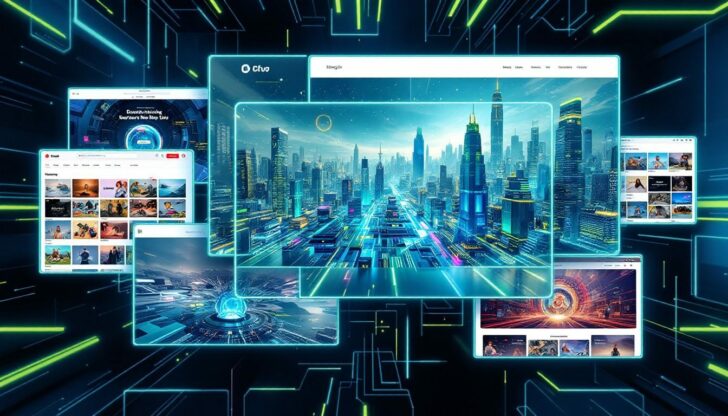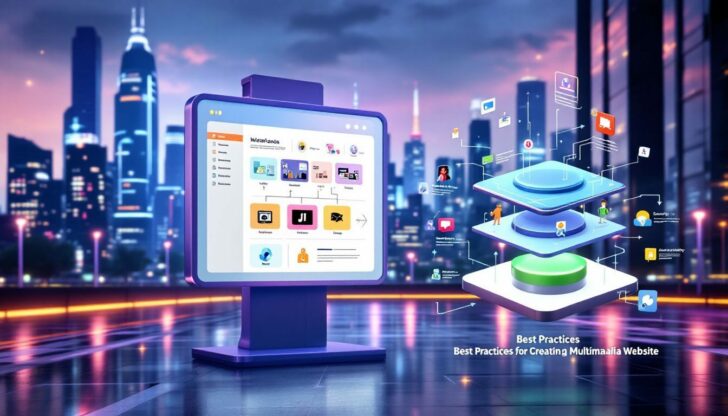Searching for an example of a multimedia website? This guide will show you how top websites use text, images, videos, and audio to engage users effectively, providing a clear example of a multimedia website in action.
Table of Contents
Key Takeaways
Multimedia websites enhance user engagement by integrating text, images, videos, and audio, catering to diverse learning styles.
Effective multimedia websites utilize interactive and visual elements to create a memorable user experience while ensuring accessibility and performance.
Promoting multimedia content through SEO, social media, and tailored email marketing is essential for increasing audience reach and driving traffic.
Understanding Multimedia Websites

Multimedia websites transform static web experiences into engaging, interactive journeys. Incorporating various media types like text, images, videos, and audio elements caters to different learning styles and preferences, thereby enhancing user engagement and retention.
The benefits of multimedia websites extend beyond mere aesthetics. They effectively convey information, make digital content more appealing, and broaden accessibility. Examples like Cyclemon and Climber illustrate how multimedia can be used creatively to showcase products and ideas, providing a rich user experience.
What is a multimedia website?
A multimedia website combines two or more types of media to create a rich user experience. This includes diverse digital media such as:
text
images
video content
audio elements
All these components work together to engage users in a multi-sensory experience.
Common examples of media types in multimedia websites include:
Text
Images
Videos
Audio elements
Multimedia examples
Integrating these various types creates more interactive and immersive experiences for audiences.
Benefits of multimedia websites
Adding multimedia content to websites breaks up text-heavy pages, catering to different learning styles and significantly improving engagement. Multimedia digital signage is generally more engaging than traditional methods, and visual elements make written content more digestible and appealing to users.
Multimedia elements significantly boost user retention by making content more engaging and accessible. This enhances promotional strategies, ensuring the audience engages more effectively with the content.
Key Elements of a Multimedia Website
Creating an effective multimedia website involves combining various digital media types like text, graphics, video, audio, and animation. Careful planning, selecting suitable media, and using the right tools are crucial for successful execution.
However, balance is key. Overloading a website with too many multimedia elements can result in longer load times and navigation difficulties, negatively impacting user experience.
Interactive elements
Interactive elements empower users to influence their media experiences through choices and feedback, making interaction more engaging and personalized. Effective features include dynamic animations, interactive maps, and hover effects, enhancing overall user experience.
Websites like Residente and Villes Paysages use these elements for engaging interactions, while Nurture Digital captures attention with stunning animations. Interactive features like polls and quizzes in online newspapers also significantly boost user engagement.
Visual elements
Visual elements play a vital role in multimedia websites, significantly enhancing user engagement and retention. High-quality visuals like images and videos are essential for creating an engaging experience, as seen on websites like ‘The Lost Pianos of Siberia’ and Style Novels, which use animations and high-quality photography to attract and retain users. The visual element of these sites is crucial in capturing audience attention.
Using various media types can elevate a website’s overall design, making it more memorable and effective in conveying its message. Images, in particular, help visualize offerings, build trust, and increase user engagement.
Audio elements
Audio elements like background music, sound effects, and narration significantly enhance user experience on multimedia websites. Visit Humboldt, for example, uses full-screen videos with beautiful background music and audio content to create an immersive atmosphere.
Using narration with music can promote deeper understanding and interaction with multimedia content, similar to how soundtracks enhance immersion in video games.
Examples of Outstanding Multimedia Websites

Outstanding multimedia websites effectively engage users through dynamic data visualizations, interactive maps, images, videos, and text that display videos. These examples serve as great inspiration for enhancing digital projects.
The EPFL report, for instance, utilizes illustrations and dynamic data visualizations to capture user interest, while the Coptic miracle example showcases engaging images and interactive maps. These examples highlight how multimedia can effectively engage audiences and can serve as inspiration for future multimedia projects.
National Geographic’s “Planet or Plastic?”
National Geographic’s “Planet or Plastic?” project brilliantly uses videos, photographs, interactive elements, and data visualizations to present its content. By combining these various media types, the project effectively engages viewers and fosters a deeper understanding of the impact of plastic pollution.
The aim of this project is to raise awareness about plastic pollution through compelling multimedia elements, making it a powerful example of how multimedia can be used for environmental advocacy.
The New York Times’ “Snow Fall”
The New York Times’ “Snow Fall” is an award-winning multimedia piece that explores the story of an avalanche through a captivating narrative. By combining text, high-quality images, videos, and animations, “Snow Fall” enhances audience engagement and promotes a deeper understanding of the story.
This project exemplifies the evolution of multimedia journalism and its ability to tell complex stories effectively, setting a benchmark for future multimedia storytelling.
Apple’s Product Pages
Apple’s product pages are a testament to the power of high-quality visuals and interactive elements in engaging users. By featuring high-quality images and videos, Apple showcases its products in detail, enhancing visual appeal and user engagement.
Interactive elements like clickable features and scrolling effects allow customers to explore product options in a hands-on manner, making the user experience both informative and engaging.
How to Create Your Own Multimedia Website

Creating your own multimedia website involves several steps, starting with careful planning and selecting suitable tools. Defining measurable objectives and understanding your target audience ensures your content aligns with marketing goals.
Platforms like Shorthand and tools like Pixpa can help create engaging multimedia content without needing technical skills, making the process more accessible.
Planning your multimedia content
Defining measurable objectives from the outset helps create content that aligns with marketing goals. Clear goals guide the selection of multimedia content types to meet intended objectives.
Understanding your audience’s preferences is crucial for tailoring multimedia content effectively. Aligning your content with defined goals and audience insights ensures the selection of appropriate media types that fit the overall strategy, especially as the audience consumes content.
Tools for building multimedia websites
Platforms like WordPress and Wix offer user-friendly interfaces for creating multimedia websites without extensive technical knowledge. Adobe Creative Cloud provides professional tools for high-quality content creation, while free tools like GIMP and Canva cater to various needs and budgets.
Lumen5, for instance, allows users to create engaging videos quickly and intuitively, offering both free and premium versions. These tools simplify incorporating diverse digital media into your website.
Best practices for multimedia use
Optimizing multimedia for various screen sizes is essential to maintain a quality user experience across devices. Adding descriptive captions and alt text enhances accessibility for users with disabilities, ensuring everyone can engage with your content.
Captions and alt text not only boost accessibility but also improve SEO, making your multimedia content more discoverable.
Promoting Your Multimedia Website
Promoting your multimedia website is crucial for reaching a wider audience and driving traffic. Using diverse channels for promotion significantly enhances audience reach and engagement, allowing you to interact with different segments and ensure your multimedia content reaches its full potential.
SEO for multimedia content
Effective use of multimedia can significantly enhance a business’s online accessibility and SEO. Using relevant keywords and providing proper metadata for multimedia assets improves visibility on search engines.
Incorporating keywords in video descriptions and file names, along with alt text for images, helps search engines understand the content, boosting SEO.
Social media platforms
Sharing multimedia content and media content on social media can drive higher engagement rates compared to text-only posts and increase the likelihood of your content being shared, reaching a larger audience.
Sharing multimedia content across various social media channels amplifies brand visibility and audience engagement, ensuring your content reaches a broader audience.
Email marketing
Email marketing is a critical strategy for driving traffic to multimedia websites. Segmenting email lists tailors multimedia content, improving engagement and relevance.
Tailored multimedia content in emails enhances user engagement and can lead to increased website traffic, making email marketing an effective promotion tool.
Challenges and Solutions in Multimedia Website Development
Developing multimedia websites presents challenges, from technical issues to user experience concerns. However, the right strategies can effectively manage these challenges.
Historically, creating multimedia content required dedicated developer bandwidth and faced resource limitations. Website security also remains a major concern, with threats like SQL injections and data breaches prevalent in multimedia website development.
Load times and performance
Users expect webpages to load within 2 seconds; delays can lead to significant drops in traffic and conversion rates. Common hurdles in multimedia website creation include varying internet speeds and user device limitations.
Effective caching techniques can enhance website loading speed, greatly improving user experience. Excessive HTTP requests due to numerous files can significantly slow down loading times, so optimizing multimedia content is crucial.
Learn more, How to check and improve your website load times.
Compatibility across devices
Ensuring multimedia formats display correctly across devices is vital for providing a seamless user experience. Responsive and mobile-accessible web design ensures multimedia elements look and function well on different screen sizes.
Compatibility across various devices and browsers is crucial for a positive user experience on multimedia websites. Rigorous testing and optimization accommodate different platforms, ensuring your multimedia content is accessible and engaging for all users.
User experience
Improving user interaction on multimedia websites can be challenging, as UI and UX design must balance aesthetic appeal and functional efficiency. Intuitive navigation and interactive features can significantly enhance user experience.
Navigational challenges can lead to user frustration, so careful design is necessary to enhance usability. Gathering user feedback helps refine multimedia elements to better meet audience expectations.
Summary
To sum up, multimedia websites transform static web experiences into engaging, interactive adventures. By integrating diverse digital media, these websites enhance user engagement and retention, making information more accessible and appealing.
Creating and promoting a multimedia website involves careful planning, using the right tools, and following best practices. Despite the challenges, the benefits of a well-executed multimedia website far outweigh the difficulties. Dive into the world of multimedia websites and let your creativity inspire and engage audiences like never before.
Frequently Asked Questions
What is a multimedia website?
A multimedia website integrates various forms of media, including text, images, videos, and audio, to enhance the user experience. This diverse approach engages visitors more effectively.
What are the benefits of multimedia websites?
Multimedia websites enhance user engagement and retention by catering to different learning styles, making content more appealing and accessible. This ultimately leads to a more effective user experience.
What are some key elements of a multimedia website?
A multimedia website should incorporate text, graphics, video, audio, and animation to provide an engaging and cohesive experience for users. These elements work together to enhance the overall effectiveness of the content.
How can I create my own multimedia website?
To create your own multimedia website, begin with careful planning and choose tools such as WordPress or Adobe Creative Cloud. Following best practices for optimizing multimedia content will enhance your site’s performance.
How can I promote my multimedia website?
To effectively promote your multimedia website, implement SEO strategies, utilize social media for content sharing, and leverage email marketing to expand your audience reach. These approaches will significantly drive traffic to your site.









